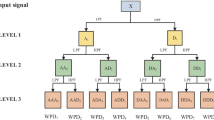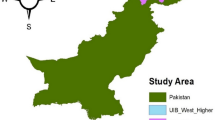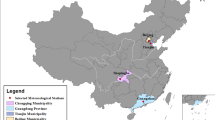Abstract
Precise rainfall forecasting modeling assumes a pivotal role in water resource planning and management. Conducting a comprehensive analysis of the rainfall time series and making appropriate adjustments to the forecast model settings based on the characterization results of the rainfall series significantly enhance the accuracy of the forecast model. This paper employed the Mann–Kendall and sliding T mutation tests to identify the mutational components in rainfall between 1961 and 2013 at four meteorological stations located in Henan Province. Wavelet analysis was utilized to determine the periodicity of the precipitation series. The model parameters were adjusted based on the mutation and periodicity findings, and appropriate training and test sets were selected accordingly. Rainfall simulation in Henan Province, China, was conducted using a combination of complementary ensemble empirical mode decomposition (CEEMD) and bi-directional long short-term memory (BiLSTM) networks. The integrated approach aimed at predicting rainfall in the region. The findings of this study demonstrate that the CEEMD-BiLSTM model, coupled with feature analysis, yielded favorable results in terms of prediction accuracy. The model achieved a mean MAE (mean absolute error) of 131.210, a mean MRE (mean relative error) of 0.637, a mean RMSE (root mean square error) of 187.776, and an NSE (Nash–Sutcliffe efficiency) above 0.910. The data processed according to the feature analysis results and then predicted; Zhengzhou, Anyang, Lushi, and Xinyang stations improved by 39.548%, 14.478%, 11.548%, and 19.037% respectively compared with the original prediction model.










Similar content being viewed by others
Data availability
Datasets and other materials are available with the authors, and may be accessible at any time upon request.
References
Adaryani FR, Jamshid Mousavi S, Jafari F (2022) Short-term rainfall forecasting using machine learning-based approaches of PSO-SVR, LSTM and CNN. J Hydrol 614(PA):128463. https://doi.org/10.1016/j.jhydrol.2022.128463
Baidu M, Amekudzi LK, Aryee JNA, Annor T (2017) Assessment of long-term spatio-temporal rainfall variability over Ghana using wavelet analysis. Climate 5:30. https://doi.org/10.3390/cli5020030
Bari SH, Rahman MTU, Hoque MA, Hussain MM (2016) Analysis of seasonal and annual rainfall trends in the northern region of Bangladesh. Atmos Res 176:148–158. https://doi.org/10.1016/j.atmosres.2016.02.008
Cui ZJ, Qin XX, Yang S (2022) Research on urban rainfall runoff prediction based on DM-LSTM. China Water Wastew 38(19):132–138. https://doi.org/10.19853/j.zgjsps.1000-4602.2022.19.021
Di Nunno F, de Marinis G, Granata F (2023) Short-term forecasts of streamflow in the UK based on a novel hybrid artificial intelligence algorithm. Sci Rep 13:7036. https://doi.org/10.1038/s41598-023-34316-3
El-kenawy EM, Abdelhamid AA, Alrowais F, Abotaleb M, Ibrahim A (2023) Al-biruni based optimization of rainfall forecasting in Ethiopia. Comput Syst Sci Eng 45(3):2885–2899. https://doi.org/10.32604/csse.2023.034206
Gao S, Huang Y, Zhang S, Han JC, Wang GQ, Zhang M, Lin Q (2020) Short-term runoff prediction with GRU and LSTM networks without requiring time step optimization during sample generation. J Hydrol 589:125188. https://doi.org/10.1016/j.jhydrol.2020.125188
Ge JJ, Zhang WH, Qu XD, Zhao SC (2022) A study of the changing ecohydrological situation of the lower Mekong River. Yangtze River 53(06):27–32. https://doi.org/10.16232/j.cnki.1001-4179.2022.06.004
Hochreiter S, Schmidhuber J (1997) Long short-term memory. Neural Comput 9(8):1735–1780. https://doi.org/10.1162/neco.1997.9.8.1735
Li M, Xia J, Chen SM, Meng DJ (2011) Wavelet analysis of precipitation changes over the last 300 years in the Beijing area. J Nat Resour 26(06):1001–1011
Li W, Tao W, Zhou XY, Pan ZS (2020) A review of time-series forecasting methods. Appl Res Comput 37(10):2881–2888. https://doi.org/10.19734/j.issn.1001-3695.2019.05.0184
Li FF, Wang ZY, Jun Qiu (2019) Long-term streamflow forecasting using artificial neural network based on preprocessing technique. J Forecast 38(3):192–206. https://doi.org/10.1002/for.2564
Ling M, Xiao LY, Jia Z (2023) Daily precipitation prediction based on SVM-CEEMDAN-BiLSTM model. Pearl River 44(09):61–68
Ling F, Li Y, Luo JJ, Zhong XH, Wang ZB (2022) Two deep learning-based bias-correction pathways improve summer precipitation prediction over china. Environ Res Lett 17(12):124025. https://doi.org/10.1088/1748-9326/aca68a
Liu YW, Li JK, Ding Q, Hao GR (2021) Analysis and prediction of rainfall runoff characteristics in the Ankang section of the Han River basin. Pearl River 42(06):59–69
Manna T, Anitha A (2023) Precipitation prediction by integrating rough set on fuzzy approximation space with deep learning techniques. App Soft Comput J 139:110253. https://doi.org/10.1016/j.asoc.2023.110253
Ren JJ, Wei HH, Zhou ZL (2022) Ultra-short-term power load forecasting based on CNN-BiLSTM-Attention. Power Syst Prot Control 50(08):108–116. https://doi.org/10.19783/j.cnki.pspc.211187
Sahraei A, Chamorro A, Kraft P, Breuer L (2021) Application of machine learning models to predict maximum event water fractions in streamflow. Front Water 3(1):652100. https://doi.org/10.3389/FRWA.2021.652100
Schuster M, Paliwal KK (1997) Bidirectional recurrent neural networks. IEEE Trans Signal Process 45(11):2673–2681. https://doi.org/10.1109/78.650093
Shao XM, Xu YQ, Yan CR (2006) Wavelet analysis of the variation of precipitation series in the yellow river basin. Acta Sci Nat Univ Pekin 6(04):503–509. https://doi.org/10.13209/j.0479-8023.2006.093
Shen ZY, Ban WC (2023) Machine learning model combined with CEEMDAN algorithm for monthly precipitation prediction. Earth Sci Inf 16:1821–1833. https://doi.org/10.1007/S12145-023-01011-W
Taccone F, Antoine G, Delestre O, Goutal N (2020) A new criterion for the evaluation of the velocity field for rainfall-runoff modelling using a shallow-water model. Adv Water Res 140(7):103581. https://doi.org/10.1016/j.advwatres.2020.103581
Tang FF, Tang TJ, Zhu GZ, Hu C, Ma Y, Li X (2022) Combining attentional mechanisms and Bi-LSTM for rainfall-based landslide displacement prediction. Bull Surv Mapp 546(09):74–79+104. https://doi.org/10.13474/j.cnki.11-2246.2022.0267
Torres ME, Colominas MA, Schlotthauer G, Flandrin P (2011) A complete ensemble empirical mode decomposition with adaptive noise. 2011 IEEE international conference on acoustics, speech and signal processing (ICASSP), prague, czech republic 22(1):4144–4147. https://doi.org/10.1109/ICASSP.2011.5947265
Venkatesh R, Balasubramanian C, Kaliappan M (2021) Rainfall prediction using generative adversarial networks with convolution neural network. Soft Comput 25:4725–4738. https://doi.org/10.1007/s00500-020-05480-9
Wang XX, Zuo XQ, Yang ZN, Zhang YM, Xie WB (2019) Spatial and temporal variation of precipitation in Chengdu from 1980–2016 based on Mann-Kendall test and information entropy. Sci Soil Water Conserv 17(04):26–33. https://doi.org/10.16843/j.sswc.2019.04.004
Wei M, You XY (2022) Monthly rainfall forecasting by a hybrid neural network of discrete wavelet transformation and deep learning. Water Resour Manage 36:4003–4018. https://doi.org/10.1007/s11269-022-03218-w
Yang JY, Zhao C, Liu GS, Xu Y (2017) Trend analysis of hydrological sequences based on mann-kendall and r/s methods - the case of suzhou city. Water Res Hydrop Eng 48(02):27–30+137. https://doi.org/10.13928/j.cnki.wrahe.2017.02.005
Yuan HC, Zhang Y, Zhang TJ (2021) EMD-BiLSTM-based forecasting model for Pacific bigeye tuna fishery. Fish Modernization 48(01):87–96
Zhang XQ, Shi JW, Zhu GY, Xiao YM, Chen HY (2022) Study of regional monthly precipitation based on CEEMD-BILSTM coupled model. Water Supply 11:8036–8049
Zhang X, Chen H, Wen Y (2023) A new rainfall prediction model based on ICEEMDAN-WSD-BiLSTM and ESN. Environ Sci Pollut Res 30:53381–53396. https://doi.org/10.1007/s11356-023-25906-9
Zhao XH, Sang YT, Zhu XP (2019) A combined CEEMD-GRNN based model for monthly runoff prediction. Yangtze River 50(04):117–123+141. https://doi.org/10.16232/j.cnki.1001-4179.2019.04.021
Funding
This manuscript was supported by the Innovation Fund for Doctoral Students of North China University of Water Resources and Electric Power. The grant number is NCWUBC202303.
Author information
Authors and Affiliations
Contributions
All authors contributed to the study conception and design. Supervision, writing—review and editing of the manuscript is the responsibility of [Xianqi Zhang]. The first draft of the manuscript was written by [Zhiwen Zheng]. Data curation and investigation were performed by [Haiyang Li]. Methodology and software were written by [Fang Liu]. Validation and visualization were written by [Qiuwen Yin], and all authors commented on previous versions of the manuscript. All authors read and approved the final manuscript.
Corresponding author
Ethics declarations
Ethical approval
This paper does not contain any studies with human participants or animals performed by any of the authors.
Consent to participate
Consent.
Consent for publication
Consent.
Competing interests
The authors declare no competing interests.
Additional information
Responsible Editor: Marcus Schulz
Publisher's Note
Springer Nature remains neutral with regard to jurisdictional claims in published maps and institutional affiliations.
Rights and permissions
Springer Nature or its licensor (e.g. a society or other partner) holds exclusive rights to this article under a publishing agreement with the author(s) or other rightsholder(s); author self-archiving of the accepted manuscript version of this article is solely governed by the terms of such publishing agreement and applicable law.
About this article
Cite this article
Zhang, X., Zheng, Z., Li, H. et al. Deep learning precipitation prediction models combined with feature analysis. Environ Sci Pollut Res 30, 121948–121959 (2023). https://doi.org/10.1007/s11356-023-30833-w
Received:
Accepted:
Published:
Issue Date:
DOI: https://doi.org/10.1007/s11356-023-30833-w




